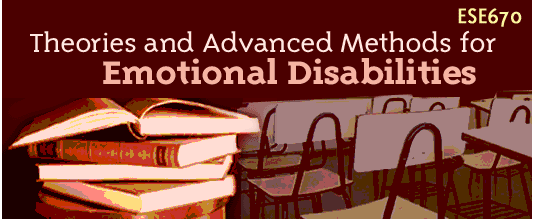
 |
|||||
| |
|
|
|
|
|
It is easy to recognize when a youngster does not fit into an academic setting. Stop for a moment and make a mental list of the signs:
Signs of trouble for a student in school 1. 2. 3. 4. 5. 6. 7. 8. 9. 10. |
Did your list match some of the items on this one?
| Externalizing | Internalizing |
|---|---|
| attention seeking | pouting |
| off task | head on desk |
| flaunting protocol, expectations | sleeping |
| pushing limits | work not attempted, no notes |
| presses for own way | not engaged |
| verbally combative | makes no responses |
| screams, yells obscenities | no eye contact |
Did you think of the behaviors from the perspective of internalizing or externalizing?
As you will note in your text readings, there are many ways of recognizing that a student is experiencing difficulty. It is much more complex to decide if the actions are situational or part of the child’s consistent way of living.
Our ability to diagnose and make determinations about emotional strengths and needs is based on philosophical and social contexts. A good diagnostician also has a “knack” for seeing disparate parts and recognizing a pattern or set of behaviors that contribute to a good understanding of the youngster and specific needs. In this way, it is both an art and science.
Most psychologists, psychiatrists and physicians use lists, similar to ones you just made to initiate the process of narrowing the child’s actions and needs to those that will be targeted. Then careful individual observations, case studies and therapeutic sessions add to the ability to correctly and accurately diagnose, using those checklists.
There is a sophisticated diagnostic processes to support these assumptions and help in recognizing consistent behavior sets. This system is in its fourth iteration and is referred to as the Diagnostic and Statistical Manual or DSM- IV. The coding system matches the International Classification of diseases coding system. This is called the ICD-9-CM.
In addition to the checklists, there is research being conducted, using physical and psychological parameters. The Minnesota Multiphasic Personality Inventory or MMPI is a sophisticated test first developed in the late 1930s by a psychologist and a psychiatrist at the University of Minnesota. It uses self-report to classify various diagnoses. It was revised about a decade ago and is often used in court to verify clinical representations.
PET scans and MRI’s have added to our understanding of the brain. Of course, we know very little about the human mind, about how to classify and provide services. We are in our infancy with classification, drug use, interventions and prevention. It is an exciting field because there is so little known and so much importance for the individual and society.
As you go through the DSM-IV, you will see that it is a sophisticated document and support of diagnosis, and that it is subject to interpretation. Used correctly, it can be a great help. It also can be easily misused with damaging results, so it is vital to be ethical in using it as a learning tool rather than a clinical devise unless you take the coursework and do the research that guides professional use.
That said, it is time to open the book and spend 3-4 hours thumbing through it.
Introduction to the DSM-IVTR
Begin by reading the acknowledgements, pp. xix through p. 37 of your DSM-IV.
Next familiarize yourself with Appendix A, pp. 745 – 757. These decision trees are the primary method for diagnosis.
Page through the glossary of terms pp, 819- 843. Choose a minimum of 25 words to put on flash cards and add to your vocabulary.
Review the GAF or Global Assessment of Functioning. This is a crucial part of utilizing the diagnostic processes. A low score on the GAF usually signals significant impairment. A high score on the GAF suggest a person is functioning well and that the symptoms they are exhibiting may be transitory, situation or that the issues are being resolved.
Now thumb through the text and begin enjoying the fascinating reading.
Do all of us a favor and remember that it is normal for human beings to have the symptoms listed to varying degrees and at different times. It does help make the reading interesting to think of people who exhibit some of the characteristics. It does not help to begin to give diagnostic names to the folks you know . . . .
Go to Activity One